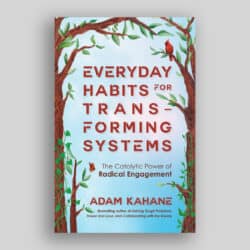Summary: There has been considerable interest in Collective Impact in Australia and Dawn O’Neil and Kerry Graham have been playing a leadership role, supported by the Centre for Social Impact, to bring the framework down under. In this update they relate the latest perspectives from Collective Impact 2014: Convene, Immerse, Learn, Australia’s first ever conference on the Collective Impact framework, and describe why Collective Impact is needed in Australia to create transformational change and how they are working together to foster a movement for social change.
Our Collective Impact journey is personal
Each of us has worked in social change for 20 years. Our combined experience spans working with children and young people, women and violence, justice and human rights, mental health and well-being, and Indigenous people and their communities. The roles we have undertaken have been equally expansive, including advocacy, program design, operations, marketing, business development, governance, and executive leadership. We met when each of us led national mental health organizations.
While we each enjoyed a somewhat similar pathway to becoming social leaders, what is more interesting is that both of us found leading national nonprofit organizations to be somewhat of a blunt instrument for the scale of change we hoped to create. For all the effort, resources, and passion, there just didn’t seem to be enough change.
Independently, we left being CEOs and became social change consultants seeking to grow our impact through working with more than one organization at a time. We both had clients who were looking to scale their impact through collaborating with others. Taking such briefs was challenging. Many leaders and organizations were weary and wary of collaboration—it sucked up a lot of time with very few tangible benefits. Plus, it was clear that clients were unsure about how to collaborate at scale—working with many organizations and across more than one sector.
During one of our collegial conversations, we looked at the Collective Impact framework. We immediately saw it as a highly useable tool that could focus the inevitably messy initial conversations and create momentum towards purposeful action and measurable outcomes. In addition, the elements of the framework provided much needed clarity on process and roles. But most of all, the Collective Impact framework made immediate sense—it had an “ah ha” moment about it and resonated with our own past experiences fostering large scale change. We agreed to introduce the framework to our clients. Thankfully, they said yes.
As we applied the framework, we started to see a difference in the way people approached the collaborative process—they became less weary and wary, and more open and engaged. It seemed the framework allowed people to feel a level of trust in the process—they could see what the process was up to and where they fit into the larger picture being created.
Off the back of this early and very limited success, we decided we needed to learn more about Collective Impact. We approached the Centre for Social Impact (CSI) and proposed that we undertake a Collective Impact study tour to the USA. CSI saw the value in the framework, and we set off on our learning adventure in September 2012.
We return to Oz as budding evangelists—resolved to promulgate the Collective Impact approach as a means to tackle our country’s most complex and entrenched social problems. We didn’t know how, but we talked about starting a movement.
We started blogging—posting our “call to action” with credible partner ProBono Australia, an online hub for not-for-profits. We spoke at any conference that would have us. And we sought out social leaders and organizations that shared our frustration with “isolated impact” and were exploring collaborative action. As a result, we worked with new Australian thought leaders like CSI, Social Leadership Australia (SLA), Ten20 Foundation, United Way Australia, Social Ventures Australia, and many others.
It is now 18 months later, and we are in the afterglow of convening Australia’s first Collective Impact conference—Collective Impact 2014: Convene, immerse, learn. We worked with the Centre for Social Impact and Social Leadership Australia to design an immersive learning experience for participants to move beyond “what is” Collective Impact and into the “how to.”
The conference sold out six weeks ahead of time and was oversubscribed with 230 leaders from government, business, philanthropy, nonprofits, and the community in attendance. All participants shared a frustration that the “isolated impact” of disconnected program-based responses to complex social problems had not created the change they desired: conditions were not changing fast enough or, in some cases, were even getting worse. While some participants came to learn more about Collective Impact, most came to learn how to start or progress a Collective Impact initiative that was already mobilizing in their area.
Why is Collective Impact needed in Australia?
There is no question that Australia is a lucky country—we rank highly on international comparative indices, are one of the wealthiest countries in the world, and weathered the global financial crisis substantially better than most other OECD economies.
However, in spite of this, and after significant commitment by successive governments to a world leading social support system, we still have too many people who live on the margins and experience significant disadvantage. Australia is no longer the egalitarian society we once were so proud of.
State and federal governments spend somewhere in the vicinity of AUD$165 billion each year on social purpose work. This equates to around 12.5 percent of GDP. About AUD$30 billion of this is funding to the nonprofit sector (and some to for-profit service providers). This compares with the $1.5 billion raised annually through philanthropy. There are around 600,000 nonprofit organizations serving a population of 23 million people.
Despite our national wealth, well-being, and significant social sector investment, we have a number of persistent, complex, and entrenched social problems:
• Disadvantage in Australia has a postcode. The most disadvantaged places in Australia have twice the rate of unemployment, disability support, psychiatric admission, and criminal convictions; and three times the rate of imprisonment (Vinson, 2007). In 2010, over 50 percent of people experiencing multiple disadvantages lived in the bottom two social-economic localities (ASIB, 2012). Despite increases in funding to these communities, their positions on rankings of disadvantage have not improved for over 10 years (Vinson, 2007).
• Mental illness accounts for 13 percent of the total burden of disease in Australia.
Approximately 600,000 Australians experience severe mental illness and some 60,000 have enduring and disabling symptoms. It is now well understood that addressing severe and persistent mental illness requires a complex mix of treatment, care, and support, which is currently delivered by siloed parts of the social system such as health, housing, income support, disability, education, and employment (DOHA PIR, 2012). Australia is half as successful as other OECD countries in finding employment for people with mental illness (ASB, 2012). While our expenditure on mental illness is increasing, so is the cost per person along with the number of people seeking service and support (AIHW, 2010 & 2012).
• Indigenous disadvantage is one of our country’s great shames. Aboriginal people in Australia have a shorter life expectancy, are more likely to die from major diseases (for example, they are 29 times more likely to die from diabetes), have lower literacy and numeracy proficiency, and are significantly less likely to finish school or to own their own home (AIHW, 2012). Ten years of policy focus and investment has barelystarted to close the gap between Indigenous and non-Indigenous Australians. • Homelessness in Australia has risen by eight percent since 2006 and the actual number of homeless people rose 17 percent (reflecting the increase in the population). A 2012 study by the University of New South Wales (Baldry et al., 2012) calculated the lifetime institutional cost for eleven homeless people aged between 23 and 55 ranged from around $900,000 to $5.5 million per person. A Victorian report (DHS-Victoria, 2011) found that “despite a thirty-nine percent increase in expenditure over the last five years, we have not seen a reduction in the number of clients accessing services and are therefore no longer homeless. This suggests that the current service system is not getting to the root cause of homelessness.”
We could go on and talk about obesity, affordable housing, and our aging population, but you get the point. When viewed as a whole, what we see is that our current responses aren’t working and aren’t sustainable. Change is urgently needed.
Now is the time for transformational change
We believe that the time has come for a “step” change in the way we respond to social disadvantage in Australia. We know that no single policy, government department, organisation, or program can tackle or solve the increasingly complex social problems we face. The current practice of governments and others of funding more and more projects and programs through a competitive funding system is simply not working and the data above proves it. We need a completely new way of working.
Over the last few years, we (and others) have conceptualized the change that is needed from a number of perspectives. The first is that our social system needs to invest more time and money enacting systemic change and focus less on conceiving social change through the lens of programs and organizations. We need to move beyond siloed responses and fragmented programs.
Related to this, we see a burning need for cross sector collaboration. For a robust process and skilled facilitation that encourages learning from multiple perspectives, creates new thinking and responses, and enables alignment of resources and collective action.
The next lens is that we need to stop doing things “to” people and start doing things “with” them. The social system—governments, nonprofits, philanthropists, and business—need to start engaging citizens in the design and delivery of systemic change as well as services.
And our last perspective is that we need to measure progress and impact. Not just for accountability reasons, but to create a culture and practice of learning and improvement; to have a basis from which to assess calculated risks for innovation, knowing when to scale what works and how to stop what doesn’t.
There are many structural barriers to this change agenda. Existing policies, strategies, and structures are deeply entrenched. Changing them requires an enormous shift in thinking, funding, practice, and, most critically, in how we work together across sectors as a system. In particular for Australia, government has a dominant role to play in rethinking the way it funds and participates in this work. But arguably deeper than the structural barriers is the personal shift required. Leading and enacting this change agenda will not be easy, comfortable, or palatable for everyone.
The birth of a movement
Despite these barriers, we are observing and fostering a movement for change in Australia. As with all movements, this starts on many fronts and seems to emerge out of a growing consciousness or awareness that change needs to happen. We believe that it needs to happen now.
Over the past seven years, a number of successful initiatives have emerged to prove our hypothesis that working collaboratively across sectors in a community will shift outcomes. Initiatives like the Blue Mountains Stronger Family Alliance (ARACY, 2011), which is changing trajectories for children and families, and 90 Homes for 90 Lives (Taylor, 2012) that is ending rough sleeping in an inner Sydney suburb. These initiatives, and others like them, have become proof points that Collective Impact can work in Australia. These “lighthouse” stories help create the step-change we are looking for.
In the last four years, we have seen a small but growing number of philanthropists and business leaders take on engaged leadership roles in systemic change initiatives for the first time. They bring with them the disciplined focus on data and results that Collective Impact requires.
And, in February of this year, we witnessed at the Collective Impact 2014 conference just how much the Collective Impact framework has resonated across sectors as a way to frame and talk about systemic change, collaboration, citizen engagement, and measuring impact.
While governments in Australia have not yet engaged beyond isolated pockets, their decade long focus on “place-based” funding structures has become an enabler of this movement. Communities across Australia are seeking to reorient and leverage place-based funding into Collective Impact initiatives. And the government is starting to take more interest.
It is the combination of these conditions—motivation borne out of frustration, willing collaborators who are not the “usual suspects,” the resonance of the Collective Impact framework, and a ready vehicle in place-based social policy—that has allowed us to assert that Australia is poised for transformational systems change. We must change or we risk being in the same place in 10 years time.
We now know that there are many ready and willing to do this work—we just need a critical mass to get the transformational change going. We believe the movement that has started will get us there and we—along with many others—are committed to intentionally growing an Australian community of practice focussed specifically on systems change and Collective Impact. Watch this space.
Websites
90 homes for 90 lives: http://www.collaborationforimpact.com/an-australiancollective-impact-initiative-tackling-homelessness
Blue Mountains Stronger Family Alliance: http://www.collaborationforimpact.com/an-australian-case-study-blue-mountains-stronger-family-alliance
Centre for Social Impact: http://csi.edu.au
Collaboration for Impact: http://www.collaborationforimpact.com
Collective Impact 2014: convene, immerse, learn: http://collectiveimpact2014.com.au
Collective Impact Australia: http://collectiveimpactaustralia.com
ProBono Australia: http://www.probonoaustralia.com.au
Social Leadership Australia: http://leadership.benevolent.org.au
Social Ventures Australia : http://socialventures.com.au
Ten20 Foundation: http://www.ten20.com.au
United Way Australia: http://unitedway.com.au
References
Australian Bureau of Statistics. (2012). Australian social trends. URL: http://www.abs.gov.au/socialtrends [April 1, 2014].
Australian Institute of Health and Welfare. (2010 & 2012). Mental health services in Australia 2007-08. URL: http://www.aihw.gov.au/publication-detail/?id=6442468381 [April 1, 2014]. Australian Institute of Health and Welfare (2012). URL: http://www.aihw.gov.au/indigenous-australians-health-and-welfare-publications/ [April 1, 2014].
Australian Research Alliance for Children and Youth. (2011). The Blue Mountains stronger families alliance. URL: http://www.strongerfamilies.co/files/Collaboration_Case_ Study_4__The_Blue_Mountains_Stronger_Families_Alliance.pdf [April 1, 2014].
Australian Social Inclusion Board, Commonwealth of Australia. (2012). Social inclusion in Australia: How Australia is faring—2nd Edition. URL: http://www.melbourneinstitute.com/downloads/hilda/Bibliography/Other_Publications/2012/Social_Inclusion_howaustralia-is-faring-report.pdf [April 1, 2014].
Baldry, E., Dowse, L., McCausland, R., & Clarence, M. (2012). Lifecourse institutional costs of homelessness for vulnerable groups. University of New South Wales. URL: http:// aifs.govspace.gov.au/2012/10/24/study-counts-the-cost-of-homelessness/ [April 1, 2014].
Department of Health and Aging, Commonwealth of Australia. (2012). Request for tender capacity building project of the partners in recovery: Coordinated support and flexible funding for people with severe, persistent mental illness and complex needs initiative. URL: http://www.bulletpoint.com.au/wp-content/uploads/2012/08/Partners-in- Recovery-RFT-DoHA-085-1213.doc [April 1, 2014].
Department of Human Services, State of Victoria. (2011). Victorian homelessness action plan 2011-2015. URL: http://www.dhs.vic.gov.au/for-service-providers/housing-andhomelessness/homelessness/homelessness-action-plan [April 1, 2014].
Taylor, Doug. (2012, August). 90 homes for 90 lives: The Woolloomooloo project. Parity, 25(5), 30-31. URL: http://search.informit.com.au/documentSummary;dn=920980112118400;res=IELHSS [April 21, 2014].
Vinson, Tony. (2007). Dropping off the edge: the distribution of disadvantage in Australia. Commissioned by Catholic Social Services Australia & Jesuit Social Services. URL: http://www.australiandisadvantage.org.au/ [April 1, 2014].
Kerry Graham has worked in social change for over 20 years and currently consults to corporations, governments, and nonprofits on collaboration, collective impact, and innovation in social change. Email: kerry@kerry-graham.com .
Dawn O’Neil has been leading effective change in the social and mental health sectors for more than 20 years and currently provides business coaching to social sector leaders in collaborative and participatory change. Email: dawn@dawnoneil.com.au .


